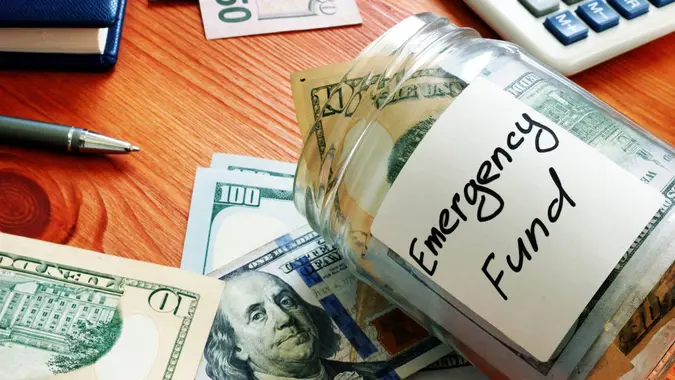How Much You Should Have in Your Savings Account at Every Stage of Life

Commitment to Our Readers
GOBankingRates' editorial team is committed to bringing you unbiased reviews and information. We use data-driven methodologies to evaluate financial products and services - our reviews and ratings are not influenced by advertisers. You can read more about our editorial guidelines and our products and services review methodology.

20 Years
Helping You Live Richer

Reviewed
by Experts

Trusted by
Millions of Readers
Every 20-, 30- and 40-something-year-old is unique, same as every teenager and senior — and that’s why stage-of-life financial advice is so hard to give. Even so, it is possible to outline a savings horizon that spans decades into the future.
While incomes, earning potentials, life circumstances, goals and endless other variables shape each person’s journey, a few general guidelines, ratios and percentages have stood the test of time.
GOBankingRates surveyed 1,063 Americans aged 18 and older from across the country, asking how much they currently have in their savings account. The results show that a whopping 35.75% have $100 or less in savings while 13.64% have between $101 and $500.
Here’s how it breaks down further:
- 10.44% report having $501 to $1,000
- 9.78% have $1,001 to $2,000
- Only about 9% have $2,001 to $5,000.
- 8.37% have between $5,001 to $10,000 saved
- A not-too-shabby 13% have over $10,000 in their savings
GOBankingRates spoke with several experts to learn more about those savings guidelines and how you can tailor them to suit your life and its many stages.
Saving in Your 20s: It’s OK To Get Started Slowly, but Get Started
Most people get their first financial reality check in their 20s, when they move out on their own for the first time. Of respondents aged 18 to 24, about 23% report having $100 or less in savings, which is better than the average of about 36% for all age brackets.
Looking at the larger amounts, 20% have between $101 to $500 saved and 14% have $1,001 to $2,000 in savings. As for the over $10,000 range, only about 7% of 18- to 24-year-olds have that much saved.
Snigdha Kumar, personal finance expert and former head of product operations for the money app Digit, said that it’s important for this age group to have some savings on hand no matter what. Kumar suggested starting out by trying to save three times your monthly rent. That may seem like a lofty goal, but experts urge young people to get in the habit of building a surplus to help them endure the unexpected.
“For example, sometimes you may have to pay the first month and security deposit upfront,” Kumar said. “And keep in mind furniture, groceries, electricity, etcetera.”
Imani Francies, personal finance expert with US Insurance Agents, said once you’ve built a surplus of cash, you can start working on your emergency fund.
“In your 20s, you should mostly work toward your emergency fund,” Francies said “If you have room financially to save for more than your emergency fund, go for it.”
Kumar agreed and suggested goals for emergency funds. “Emergency funds should have three to six months of expenses at a minimum and for a more aspirational goal, aim to save for 12 months.”
In Your 30s: Get Serious About Saving
Life is different for everyone during this decade too, of course. But for many people, their 30s bring kids, a home, more income and a much greater responsibility to save than ever before. According to the GOBankingRates survey, 39% of respondents aged 25 to 34 report having $100 or less in savings, about 12% have between $101 to $500 saved and 9% have between $1,001 to $2,000 in savings. Only about 11% have over $10,000 saved.
Kumar said financial responsibility in your 30s is all about building on the good habits you set forth in your 20s.
“The main goal for this stage of life is stability,” he said.
Middle Age: What You’ve Been Saving for Is Just About Here
If you started saving in your 20s, you’ll be grateful for your early efforts by the time you reach your 40s.
“Two to three times the current income is a good benchmark for age 40 and four to five times for age 50-plus,” Kumar said.
However, if you thought it was hard to save when you were young and free, wait until you get to middle age. By this point, many people are planning to pay for their kids’ college at the same time as they’re trying to save for retirement. Likewise, plenty of people spend this stage of life sandwiched between the financial rock and hard place of caring for aging parents while also raising young children.
Without a healthy savings account, the present will be a challenge and the future could be a bust. Of respondents aged 35 to 44, an unsettling 42% report having $100 or less in savings, 9% have between $101 to $500 saved and 9.52% have between $1,001 to $2,000 in savings. Surprisingly, only about 11% have over $10,000 saved, which is about the same as people in their 30s.
In Your 60s: You’re on Deck for Retirement
By the time you enter your seventh decade, you should be putting the finishing touches on a lifetime of saving — but don’t panic if you’ve fallen behind.
When it comes to savings, those aged 65 and over are doing OK compared to other age groups, with 32.95% reporting $100 or less saved. However, 15.91% have only between $101 to $500 put away, showing room for improvement. On a positive note, a sizablepercentage — 18.18% — have over $10,000 in savings, outpacing all other age groups. But only 5.11% fall into the $501 to $1,000 bracket, the lowest of any group. So while seniors are saving more overall, many still lack an adequate emergency fund between $500 to $1,000.
“If they don’t have enough stacked away for retirement, then this is a good time to play catch up and save in order to prepare,” Kumar said.
The Secure 2.0 Act of 2022 relaxed many restrictions on retirement plans to incentivize late-life saving. The legislation removed age barriers on contributions — even beyond 70 — loosened the standards for required minimum distributions (RMDs), expanded catch-up contributions and more.
“You can contribute more to a 401(k) as well as IRAs to build your retirement nest egg,” Kumar said.
If you’re not where you should be at 60, be grateful that you’re 60 now — there’s never been a better time to be a senior saver.
The Retirement-Focused Lifetime Saving Strategy
Marco Sison, financial coach with Nomadic FIRE, said that savings strategies at every age should be calculated with the same goal in mind: retirement.
“The average cost of retirement is roughly $750,000,” Sison said. “More than the combined cost of university education, raising a child and buying a home. The best way to ensure you are saving enough for retirement is to use a spreadsheet and calculate the present value of your goal at specific ages.”
Sison scratched out the math. “To retire with $750,000 by age 70, you will need to have saved $46,000 before you turn 30, $92,500 before you turn 40, $186,000 before you turn 50 and $373,000 before you turn 60,” Sison said. “For a quick calculation, estimate your nest egg doubles roughly every 10 years, assuming a 7% annual return on your investment.”
Brooke Barley and Laura Beck contributed to the reporting for this article.
Methodology: GOBankingRates surveyed 1,063 Americans aged 18 and older from across the country from November 27 to November 29, 2023, asking twenty-two different questions: (1) What category best describes your current financial institution?; (2) Have you considered changing banks within the past year?; (3) If you have considered changing banks in the past year, were any of the following factors? (select all that apply); (4) Which feature, perk or other offering is most important to you when opening an account with a new institution?; (5) Are you currently satisfied with all your banking products and services offered by your bank or credit union?; (6) Would you ever have different types of accounts across multiple banks? (i.e. checking at Chase, but savings at TD Bank); (7) What is your most preferred method of banking?; (8) Which of the following is the biggest factor of you staying with your current bank?; (9) Which of the following bank accounts do you currently use or have open? (Select all that apply); (10) How much is the minimum balance you keep in your checking account?; (11) How much do you currently have in your savings account?; (12) What amount of a sign-up bonus would make you consider switching banks?; (13) Have you considered using any app-only banking platforms (such as neobanks) in the past year (e.g. Current, Chime, Dave, etcetera.)?; (14) How important is it to you for your bank to be affiliated with a crypto exchange or platform?; (15) In the past year how often have you written a physical check?; (16) When was the last time you visited your bank in person?; (17) Why would you choose to visit your bank in person? (Select all that apply); (18) Have you had an overdraft on your checking account in the past year?; (19) How much do you trust your current bank to act in your best interest?; (20) How much do you trust your current bank to protect your private information?; (21) Do you trust regional banks more than national banks?; and (22) How much cash do you keep at home? GOBankingRates used PureSpectrum’s survey platform to conduct the poll.
 Written by
Written by  Edited by
Edited by 

























